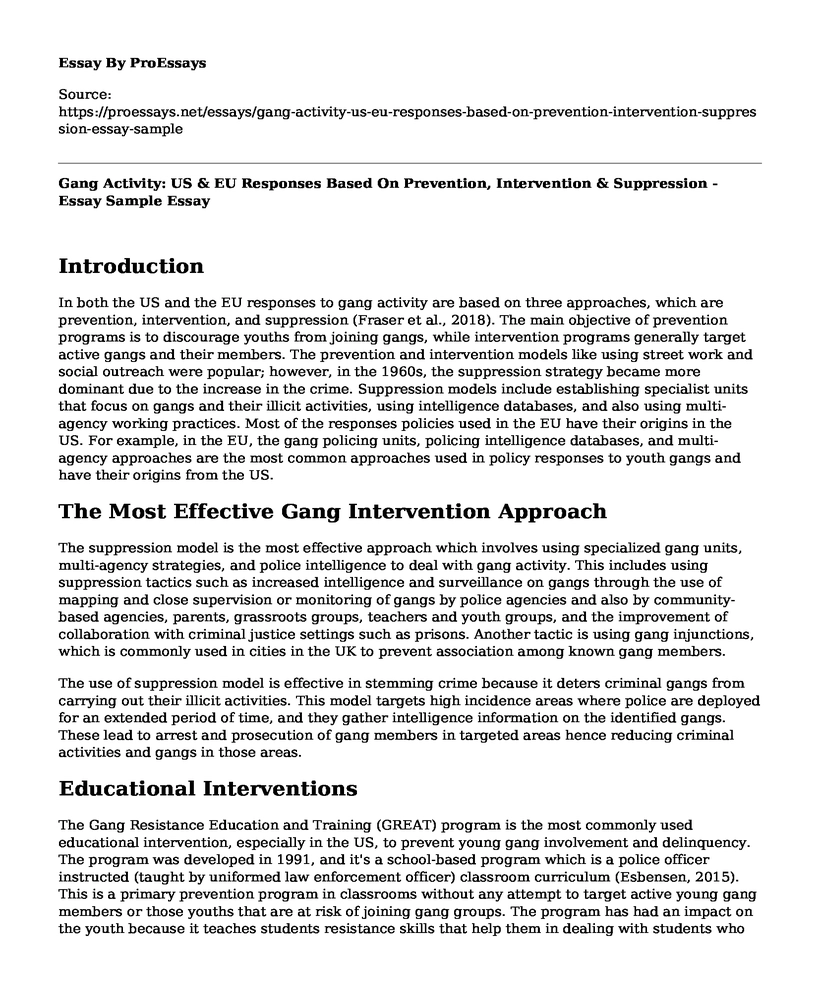Introduction
In both the US and the EU responses to gang activity are based on three approaches, which are prevention, intervention, and suppression (Fraser et al., 2018). The main objective of prevention programs is to discourage youths from joining gangs, while intervention programs generally target active gangs and their members. The prevention and intervention models like using street work and social outreach were popular; however, in the 1960s, the suppression strategy became more dominant due to the increase in the crime. Suppression models include establishing specialist units that focus on gangs and their illicit activities, using intelligence databases, and also using multi-agency working practices. Most of the responses policies used in the EU have their origins in the US. For example, in the EU, the gang policing units, policing intelligence databases, and multi-agency approaches are the most common approaches used in policy responses to youth gangs and have their origins from the US.
The Most Effective Gang Intervention Approach
The suppression model is the most effective approach which involves using specialized gang units, multi-agency strategies, and police intelligence to deal with gang activity. This includes using suppression tactics such as increased intelligence and surveillance on gangs through the use of mapping and close supervision or monitoring of gangs by police agencies and also by community-based agencies, parents, grassroots groups, teachers and youth groups, and the improvement of collaboration with criminal justice settings such as prisons. Another tactic is using gang injunctions, which is commonly used in cities in the UK to prevent association among known gang members.
The use of suppression model is effective in stemming crime because it deters criminal gangs from carrying out their illicit activities. This model targets high incidence areas where police are deployed for an extended period of time, and they gather intelligence information on the identified gangs. These lead to arrest and prosecution of gang members in targeted areas hence reducing criminal activities and gangs in those areas.
Educational Interventions
The Gang Resistance Education and Training (GREAT) program is the most commonly used educational intervention, especially in the US, to prevent young gang involvement and delinquency. The program was developed in 1991, and it's a school-based program which is a police officer instructed (taught by uniformed law enforcement officer) classroom curriculum (Esbensen, 2015). This is a primary prevention program in classrooms without any attempt to target active young gang members or those youths that are at risk of joining gang groups. The program has had an impact on the youth because it teaches students resistance skills that help them in dealing with students who participate in gang activity and violence. It also teaches students how to identify the characteristics of gang members that enable them to avoid gang activity. This program has reduced gang violence and also helped students to deal with gang problems when they face them.
EU Programs
Gang programs in Europe have their roots from the US gang programs; however, they present a confusing picture due to the considerable inconsistency giving definition term 'gang' or its meaning, collection of statistics, and how to categorize young people. These variations make it difficult to understand the how the issue t of gangs is spread across Europe. However, there have been collective efforts to respond to gangs in the EU. For example, Spain developed the "police coordination and intervention plan" to respond to violent youth groups. The UK established the "Ending Gangs and Youth Violence" gang strategy to combat gangs and youth crime. I don't think the EU programs appear to be more effective because of variations in meaning and measurement, which fails to paint the real picture of gang activities in Europe. When a consensus of these variations is arrived at, that is when it will be possible to establish the effectiveness of programs in Europe.
References
Esbensen, F. A. (2015). The Gang Resistance Education and Training (GREAT) Program. The Handbook of Gangs, 369.
Fraser, A., Ralphs, R., & Smithson, H. (2018). European youth gang policy in a comparative context. Children & Society, 32(2), 156-165.
Cite this page
Gang Activity: US & EU Responses Based On Prevention, Intervention & Suppression - Essay Sample. (2023, May 16). Retrieved from https://proessays.net/essays/gang-activity-us-eu-responses-based-on-prevention-intervention-suppression-essay-sample
If you are the original author of this essay and no longer wish to have it published on the ProEssays website, please click below to request its removal:
- Similarity and Differences Between China and India Inequality
- Elderly Homelessness in LA County - Research Paper
- Essay Sample on Violence: A Never-Ending Cycle in Society
- Essay Sample on Racial Sensitivity: America vs. Other Nations
- Essay Example on LGBT Rights & Equality: Booker Muhlayasia Case
- Women Immigrants: Struggling to Obtain American Citizenship Status - Essay Sample
- Essay Example on NYC: A Melting Pot for Immigrants: 4 Decades of Transformation







